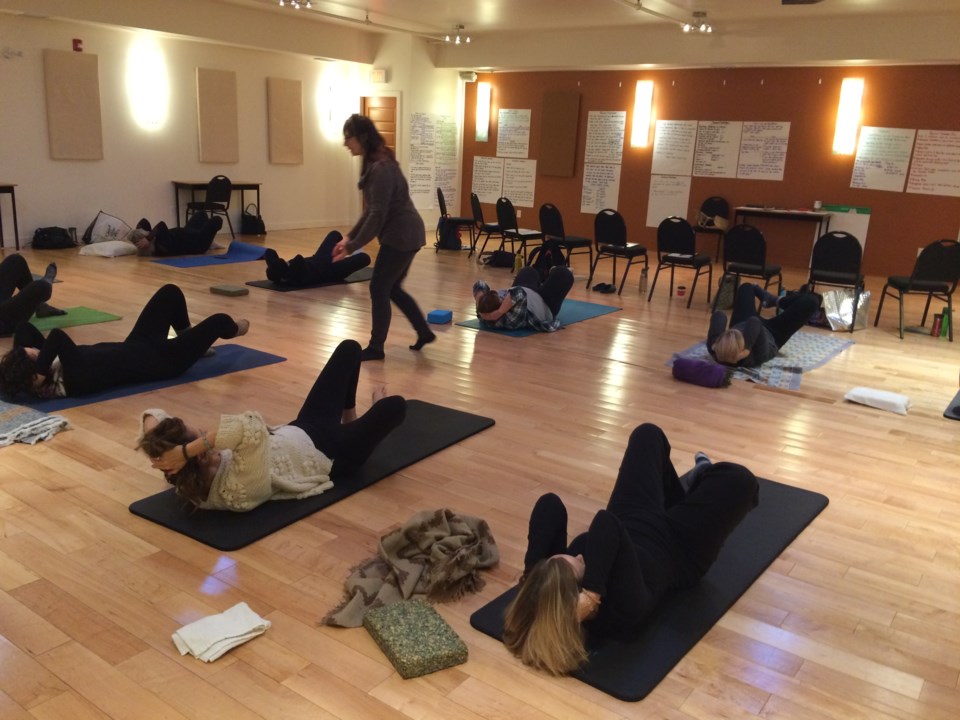International Association for the Study of Pain (IASP) reports that chronic pain is prevalent worldwide, including lower back and neck pain. Those who experience either or both conditions can attest that it is a major source of suffering.
A wide variety of medical experts, kinesiologists, physiotherapists and even professional dancers have been trying to figure out the best way to treat people in pain, and not just for the short term. qathet resident Emma Bashford is one such person, and her search for her own pain relief came from a practice called somatic movement.
"I was really into the outdoors when I was younger; I was into snowboarding and mountain biking," said Bashford. "I've broken a lot of bones over the years, and I just had one accident about 10 years ago that I didn't recover from."
That's when Bashford began to look for a long-term solution to what she describes as persistent and often debilitating neck pain, stemming from a history of extreme-sports injuries and emotional stress.
The core IASP definition states that pain is an unpleasant sensory and emotional experience associated with, or resembling that associated with, actual or potential tissue damage.
Bashford tried other practices and treatments however, when she took her first somatic movement workshop on Cortes Island, she said she discovered something that seemed to finally help her.
"I just knew that as soon as I discovered it, [somatics] was like nothing else that I'd ever experienced," said Bashford.
Recently, a clinical guideline from American College of Physicians (ACP) recommended that clinicians and patients should consider initial exercise practices such as yoga, tai chi, or Pilates for chronic low back pain, and currently, there is some evidence now regarding the effectiveness of mind-body interventions such as Hanna Somatic Education (HSE), which was developed by Dr. Thomas Hanna in the 1970s.
"It's a bit of a buzzword at the moment; it's kind of trendy, like vagus nerve," said Bashford. "There's different sorts of meanings and uses of the word somatic, but in the work that I do, it's a body of work developed by the late neuromuscular pioneer Thomas Hanna."
Somatic comes from the Greek word meaning living body.
"So it's a really slow, mindful movement practice," said Bashford, who now teaches the practice in qathet.
"Somatic movement is a comprehensive system to reeducate the brain, the nervous system and the muscles," added Bashford. The movements are not at all like yoga, tai chi, or stretching, but slow movements called pandiculation, which is a system of movement to reeducate the brain, the nervous system and muscles.
"So if you just think about your own body, nervous system and mind that all of us have, we all have histories," said Bashford. "Those histories are imprinted on our nervous system, then these histories show up as contractive muscular patterns and the habits of movement and stiffness that go with that."
Bashford said somatics can be helpful for both physical and emotional trauma, repetitive motion injury, accidents and after surgeries.
"The brain has forgotten how to let go of the muscles, so somatics helps the muscles and the muscle group to release tension," she added.
The idea of somatics is to restore flexibility, strength, alignment and balance in the physical body and also emotional states. Repetitive injuries and neck and back pain usually stem from a sedentary lifestyle, but intense activity such as mountain biking can also cause long-term injuries. Human hunter-gatherer ancestors were in constant movement, but also completely rested when needed.
"If we can move better, then we feel better," said Bashford.
Small studies on the effects of Hanna Somatic Education to manage pain, published in the National Library of Medicine, found that: “Clinical sessions significantly reduced chronic low back and/or neck pain and resulted in reduction in the use of pain medication and in the number of visits to physicians.
For more information, email [email protected].
Join the Peak’s email list for the top headlines right in your inbox Monday to Friday.




